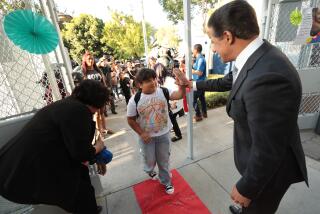9-Year-Olds Better in Reading, Math
WASHINGTON — The nation’s 9-year-olds last year posted their best scores in reading and math in more than three decades. Older students didn’t fare as well.
At the same time, achievement gaps between racial groups narrowed, according to results of the 2004 National Assessment of Educational Progress announced Thursday.
Education officials and advocates attributed the 9-year-olds’ performance to an emphasis in elementary schools on getting children reading as early as possible. They said the results also showed more attention must be paid to students in secondary schools.
“We need to go to work,” Education Secretary Margaret Spellings said.
Spellings also credited No Child Left Behind, the education law President Bush signed in January 2002 that mandates frequent testing of students to chart their progress in reading and math.
On the National Assessment, sometimes known as the nation’s report card, 9-year-olds earned their highest scores since the tests were first given -- reading in 1971 and math in 1973.
The exams are given periodically to 9-, 13- and 17-year-olds.
On a scale of 0-500, the 9-year-olds scored 219 in reading in 2004, compared with 212 in 1999, the last time they were tested, and 208 in 1971. In math, they scored 241 last year, 232 in 1999 and 219 in 1973.
The message is “that persistence pays off,” said Francie Alexander, a member of the National Assessment Governing Board, which oversees the test.
Results were mixed for 13-year-olds and remained flat for 17-year-olds.
Thirteen-year-olds earned their highest math scores ever, but their reading scores were a few points better than in 1971 and about the same as in 1999.
In math, their average scores went from 255 in 1973 to 276 in 1999, and climbed to a high of 281 in 2004.
In reading, the trend was 255 in 1971, rising to 259 in 1999 and holding at that level in 2004.
Seventeen-year-olds continued a trend of flat scores in both subjects, although greater percentages reported taking advanced math, such as second-year algebra or calculus.
Their reading score of 285 was the same in 1971 and 2004, while it was 282 in 1999.
Math scores increased from 304 in 1973 to 308 in 1999 before falling to 307 in 2004.
Among racial groups, most gaps in reading and math scores showed some narrowing.
Every age group, except for Latino 13-year-olds, cut into the achievement gap with whites in comparison with the 1970s.
In reading, black and Latino students scored higher than in the early 1970s.
More to Read
Sign up for Essential California
The most important California stories and recommendations in your inbox every morning.
You may occasionally receive promotional content from the Los Angeles Times.










